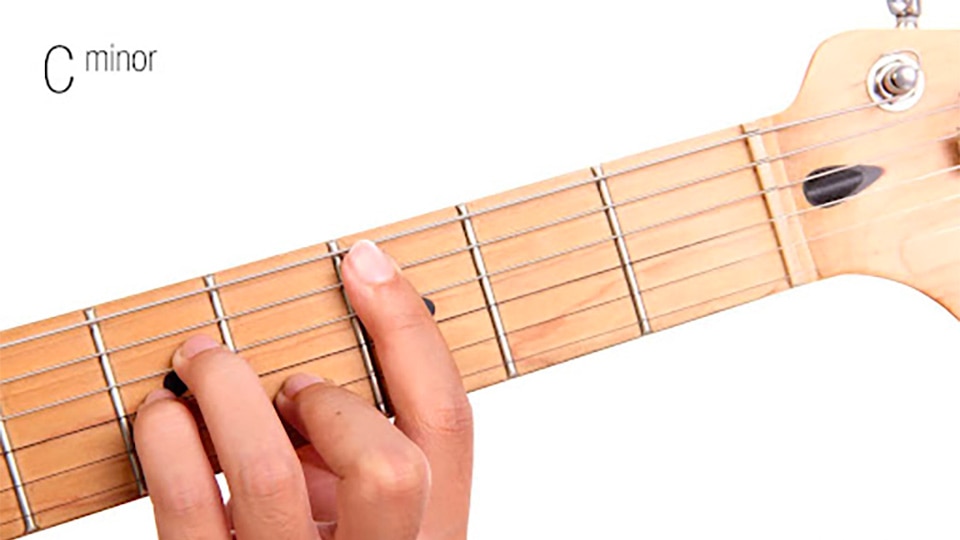C Minor is a powerful, emotive chord that's frequently used in various genres of music, from classical to rock, pop, and even blues. Understanding how to play it correctly can open up a new world of songs for you to learn and experiment with.
In this comprehensive guide, we will walk you through four distinct ways to play the C Minor chord, helping you to broaden your guitar playing skills and add more depth to your musical expression.
The Basics
Before we delve into the world of C Minor, let's quickly recap the essentials of guitar playing. If you're an absolute beginner, the guitar has six strings, each of which corresponds to a specific note: E, A, D, G, B, and E from the thickest to thinnest, respectively. The guitar neck is divided by metal strips called frets, and it's by pressing down the strings between these frets that we create different notes and chords.
For the purpose of our instructions, we'll refer to your index, middle, ring, and pinky fingers as 1st, 2nd, 3rd, and 4th fingers, respectively. Having a basic understanding of these aspects will make learning the C Minor chord considerably easier.
What Is the C Minor Chord?
The C Minor chord, denoted as Cm in chord charts, is made up of three distinct notes: C, Eb (E flat), and G. In music theory, it's known as a minor triad, which means it consists of the root note (C), the minor third (Eb), and the perfect fifth (G). The minor third, or flat third, is what gives the C Minor chord its distinctively melancholic and introspective sound, setting it apart from its major counterpart.
1. C Minor At the 10th Fret
The first method we'll dive into is the C Minor chord played at the 10th fret, without barring. This is an excellent starting point for novice guitarists due to its straightforward finger placement.
-
First, place your 1st finger (index finger) firmly on the 10th fret of the 4th string (D string).
-
Next, position your 2nd finger (middle finger) onto the 11th fret of the 1st string (high E string).
-
Place your ring finger on the 12th fret of the 3rd string (G string).
-
Lastly, position your pinky finger on the 13th fret of the 2nd string (B string).
-
Begin strumming from the 4th string (D string) down to the 1st string. Avoid strumming the 6th string (low E string) and the 5th string (A string), as these aren't part of the chord.
Remember, the quality of sound is crucial. Each note should resonate clearly without any muted or buzzing sounds.
2. Barre Chord
Let's discuss the barre chord, known for its complexity and versatility. It might seem daunting at first, especially for the pressure it requires from your index finger, but with consistent practice, it becomes manageable.
-
Start by placing your 1st finger (index) at the 3rd fret on the 5th string (A string), producing the root C note. To make this a barre chord, barre from the 5th string to the 1st string at the 3rd fret.
-
Position your 2nd finger (middle finger) onto the 4th fret of the 2nd string (B string), which will play an E flat note.
-
Place your 3rd finger (ring finger) onto the 5th fret of the 4th string (D string). This string now becomes the G note.
-
Your 4th finger (little finger) should be placed on the 5th fret of the 3rd string (G string), contributing a C note to the chord.
While strumming, ensure that all the notes ring out clearly and none of the strings are muted or buzzing.
3. Triad on Higher Strings
Now let's explore playing the C minor chord as a triad on the higher strings. This technique produces a high-pitched variation of the C Minor chord and can add some melodic diversity to your playing:
- Use your index finger to barre strings one through three at the 8th fret --- and that's it.
Keep in mind, you should only strum the strings that your fingers are on. Listen for clarity in each of these notes as you strum.
4. C Minor 7
![[RS+] News How To Play C Minor on Guitar 4 Different Ways - img](http://staticctf.ubisoft.com/J3yJr34U2pZ2Ieem48Dwy9uqj5PNUQTn/6s40BAZWiJkzFSwIC2DnA3/11a8e84ddc7f0a1e89aad39efc50e2cc/cmin2.jpg)
Lastly, we'll learn the C Minor 7 chord. It's a small variation on the standard C minor, but it can add a new layer of complexity and a jazzy feel to your music:
-
Start by barring all of the strings at the 3rd fret with your 1st finger (index finger).
-
Next, position your 2nd finger (middle finger) onto the 4th fret of the 2nd string (B string). This string will now play an E flat note.
-
Finally, place your 3rd finger (ring finger) on the 5th fret of the 4th string (D string). This will make the string resonate as a G note.
Strum from the 5th string down, ensuring the notes ring out clearly. The additional 7th note (the B flat) produced by barring the G string at the 3rd fret provides a jazzier, more complex sound to the chord.
Practice Daily
There you have it, four distinct ways to play the C Minor chord on the guitar! Whether you're a beginner or an experienced guitarist looking to enrich your skills, knowing different ways to play the same chord can enhance your creativity and flexibility as a musician.
Practice is key. With consistent effort, these techniques will soon become second nature, allowing you to easily incorporate the C Minor chord's evocative sound into your musical repertoire.
For best practice, it's a great idea to try new genres, artists, and guitar styles to open your musical mind to the guitar's potential. For more than 6,000 songs and advanced learning platforms, check out Rocksmith+.
Sources:
Music History including Genres Styles, Bands And Artists over 90 years | The People History
basicmusictheory.com: C minor triad chord | Basic Music Theory









